Rethinking Natural Wood Siding
While waiting patiently for the construction permits to get issued, I’ve been thinking really hard about the ramifications of using natural stained wood on heavily exposed areas of my house. It’s been a concern of mine from the very beginning, but only after seeing in person what happens to Brazilian Ipe after a year in the sun and rain have I started to really question whether or not I want so much exposed wood on the outside of my house. Ipe is such a dense wood that you aren’t even supposed to stain it, but in order to keep it from silvering, you pretty much need to oil it down every year. Considering that part of this wood will be inside and part will be outside, I’m just not convinced I can maintain anything close to a uniform, “newish” appearance no matter what I do (and I don’t want to oil or stain a good portion of the house every year).
This concern seems to fly in the face of a lot of modern architecture lately, especially in the Pacific Northwest. Take a look at some really nice wood-heavy modern designs from the last few years:
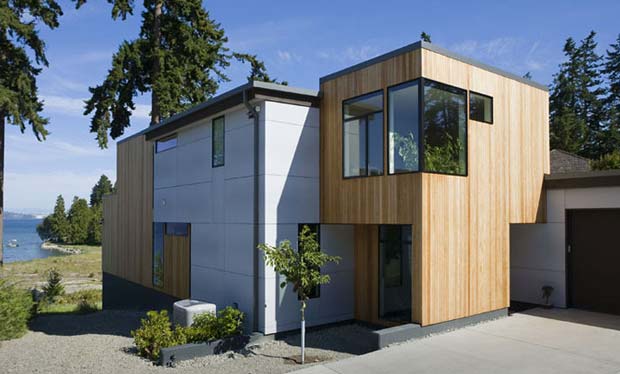
Build LLC

PB Elemental
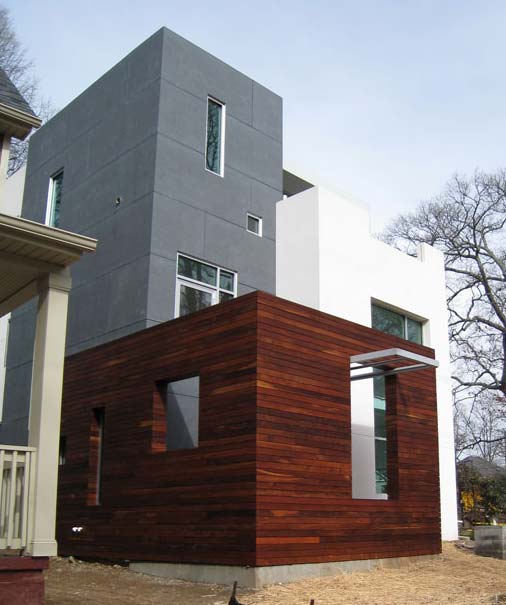
Scott West
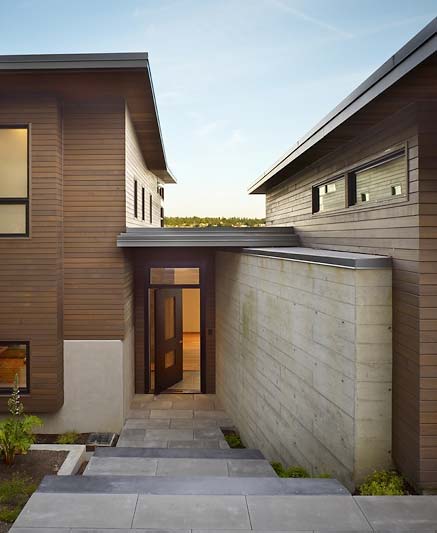
SkB Architects

Unknown
While all of these houses look spectacular, I just can’t help but wonder what they will look like in 5 or 10 years, especially in a climate like Seattle that gets quite a wide range of weather. From what I can tell, it’s the sun more than the water which makes wood fade or go silver, so maybe in that sense, Seattle isn’t so bad.
Because of my concerns, I’ve been exploring alternatives including the following:
- Using another wood like mahogany or cedar, which may be easier to stain when it starts to fade
- Painting the wood from the get-go, or at least being ready to paint it if and when its appearance goes downhill
- Using a synthetic wood paneling system which should hold up indefinitely to the elements
- Using a plastic-aluminum cladding system and tucking a bit of wood accenting in sheltered areas of it
If anyone has any experience that could be helpful, I’d love to hear it. Once again, here is the mostly-final design we’re talking about:

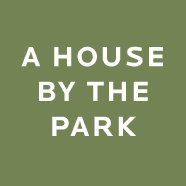
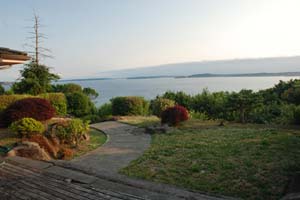
Mike,
I don’t have any experience with wood panel siding, but have you looked at the possibility of using the silvering of the ipe into your design? I was thinking along the lines of what they do with copper and using the green patina in design.
I know you said the design was pretty much set in stone, but I would assume changing materials/colors wouldn’t be all the difficult at this stage.
Kyle: Good suggestion, but for some reason, I just really don’t like the look of silvered wood. I do like the copper oxidation effect quite a bit, but I just feel like the wood silvering comes off as pretty dull.
Mike, first off I’d like to say great blog! I was referred to it from the Build Blog and Andrew. I am currently building a project in South Capitol Hill using vertical tongue and groove cedar with the rough side exposed. You can see photos of the project @ http://www.remington-court.com
There are many things to consider when using a wood cladding system. Ipe is most definitely one of the strongest and most beautiful woods (also one of the most expensive) out there. You can see some nice examples of it on Sebastian Mariscal’s website (www.sebastianmariscal.com). He uses it on most of his projects. It does, however, require a lot of labor even before applying it. It needs to be oiled on all 6 sides of the board (and also whenever the boards are cut) prior to installing on a wall. It also must be pre-drilled. Then, like you mentioned, must be maintained quite frequently.
Cedar is less expensive and has a proven track record in the northwest. By exposing the rough side, the wood is able to absorb more of the stain (but keep in mind you get more texture on your finished wall than when you expose the smooth side). We are using Clear Grade B and better (no knots) on our project. There are also many options when it comes to staining it. In other words there is more of a range of colors that you can apply than you can to ipe (since it is such a dark wood already). You can easily make cedar appear to look like Ipe with the correct stain (see David Foster’s townhouse project on East Denny just east of Madison) We are using “Transparent Cedar” PENOFIN on our cedar, but there are other good stains such as SIKKENS (seen on many log cabins, with more sheen) and CABOTS.
We sided our building about 3 months ago and applied one coat of Penofin immediately after. The pictures you see on the website are immediately after the stain was applied. If you were to visit the building today you would see that the wood has already faded quite a bit on the South side of the building. You can also get the wood pre-stained at a staining house which is better if you are installing a “rainscreen” siding system since the back of the board is exposed to water. We will be applying another coat of Penofin at completion and are budgeting to apply more in the years to come.
We, as architects, love the weathering of materials (steel rusting/galvanization, concrete cracking, wood fading, etc.) and are expecting the wood to go gray at some point. Our only concern is that the south side of the building will go gray and the north side will remain stained. I was told (and am skeptical) that water contributes to the silvering of wood more than the sun.
I haven’t seen many mohogany siding applications in Seattle (or anywhere else) probably because it is such an expensive hardwood.
Please feel free to contact me if you would like to visit the project to see the wood in person. Sorry for such a long post. Keep up the good work! You chose a great firm to design your home.
Mike,
On the copper front…
While I was at UIowa in the 90s, the university commissioned Frank Gehry to design a wild-looking advanced technology center. The front view:
http://k41.pbase.com/o4/32/619332/1/57477656.mg30635ls.jpg
The building’s rear features a windowless, boat-like lab which is completely copper-clad. Here it is:
http://k41.pbase.com/o4/32/619332/1/62033716.54JXKwjF._MG_81191.jpg
If memory serves, the copper was initially green ala the Statue of Liberty. After a bit of time in the open, it turned brown. Without knowing anything about this, I’m under the impression that the oxidation process generally works in reverse. So, it’s possible that it was treated with something. No idea.
In any event, against the concrete, it strikes me as being the basic aesthetic that you’re after…and zero wood rot.
Not likely the cheapest approach initially and no idea re the maintenance. There’s little doubt, however, that it will stand the test of time.
Regards,
Nick
Mike,
Just recently finished a design in Souther Ontario for a residential project and we went through the same debate with the clients. They ended up deciding to go with cedar siding with a similar treatment to the Sikkens treatment for log homes mentioned above, but another option we were considering was Cape Cod finished wood siding (http://www.capecod.ca/) which is a factory finished wood siding that you can apply any custon colour to and comes with a good warranty against fading. Not nearly as high end as an IPE finish but, a low maintenance and cost effective solution.
Ryan
@Nick – I get an Error 403 Forbidden on those image links :-(
I live just outside of Portland. We built our home fifteen years ago and face west on a hill. We have seen every kind of weather the Pacific Northwest dishes up including a rare tornado. My advice to you?
Go synthetic, go maintenance free, go where ever you need to go to stay away from having to touch your siding, your deck, your whatever, more than every ten-fifteen years. I can’t tell you how sucky maintenance is on wood. It’s sucky, sucky, sucky. Way sucky. And when it goes south from the elements it looks sucky until you get out there and do something with it. I even hate my wood floors on the interior. The sun got to them, too.
I’m just sayin’. I’d do things differently. A rock hut looks good sometimes.
PS Love the house, love your blogs.
quick question, for your garage and part of your house are you doing reinforced concrete or panels?
looks like a lot of concrete…
I don’t know much about this wood, but I saw it on Renovation Nation and it looked like some pretty cool stuff. You might not want to give it a try since it’s pretty new as siding material, but it still might be worth looking into. The wood is called Paulownia, and the episode it’s talked about is:
Renovation Nation Episode: Petersham, MA, Timber Framing & Mud Walls
http://planetgreen.discovery.com/tv/renovation-nation/episode-guides/?page=2
Just looking for options myself, and thought this might be expensive, researching it might lead to better ideas.
Your post reminded me of a project at Olson Sundberg Kundig Allen Architects, when I used to work there:
http://www.oskaarchitects.com/Projects/117/Lake-Washington-Residence#
The siding is reclaimed Redwood. My understanding is that it had to be re-sealed every few years to protect it. I wish I had more technical details to offer, but it wasn’t my specialty. :)
How sustainable is the synthetic paneling?
We redid our 1950’s ranch house 3 years ago and used a limited amount of grade A cedar siding. I love the look. On the advice of our architect, we limited the area (mostly for cost reasons) to near the doors, front and back. The reason being that is where we would come and go, and where we would see it the most. I’m now glad we limited the amount due to the maintenance issues. We have gotten away with re-coating every other year with Aquaspar, and we get full western exposure on one side. Good luck, love your site.
Just came over from Seattle Bubble. Having lived in Texas for a couple of years recently, I can tell you that the sun is HARSH on wood. Most everyone down there builds wood fences and then leaves them unstained, and in a matter of weeks you can see silvering starting. In less than ten years the fences are completely falling down. And the damage is far worse on the sunniest exposures. Food for thought.
Nick: Thanks for the great tips on cedar. With wood, my problem would probably be even worse than yours because I have the north/south differential to worry about as well as the inside the glass/outside the glass differential. Combined, it just seems like a recipe for a lot of maintenance and unpredictable results.
Nick #2: Interesting call on the copper! I will look into that. In modest doses, it could work great!
Ryan: With the Cape Cod stuff, that’s pretty much just painted pine, right? No special qualities other than it’s painted so it doesn’t silver, correct?
Bridget and Jenny P.: Thanks for the advice. Spoken like kindred spirits. If you hate it, I’m sure I will hate it just as much.
Lou M.: Actually, it’s paneling.
Jason: Cool! I’ve seen that house from the water. Love it. As for the synthetic stuff, there are varieties of paneling that are made out of recycled materials and other organic elements. I’m sure some are pretty environmentally unfriendly options too though.
Jbeans: Good info. Wood is becoming less desireable with every new comment. :)
Have you considered something along the lines of Parklex Facade. There are a few homes in the Seattle area that have used it and it appears to hold up quite well in our environment.
Does anyone know of a manufacturer of a realistic, synthetic wood paneling that can take a great deal of punishment? We’re renovating a brownstone in NYC and natural wood would take too much of a beating with all the traffic, but on the flip side, we don’t want it to look “fake”. Any ideas?
I am in Seattle and installed an IPE deck two years ago. I left it raw and didn’t put any oil on it. In a couple of months it had faded to silver and looked exactly like the first picture on the website you linked to (http://lumberdepot.net/deck_expect.htm).
I was fine with the silver color since I wanted a low maintenance deck. In the two years it has been down I have power washed it once just to get the mildew off of it and probably could have just hosed it down and given it a light scrubbing After power washing it looks less silver but not “like new” and it turns silver again in a month or so. It does show staining under anything place on it i.e flower pots but hte stains go away over time if exposed to the sun.
I have had zero issues with splinters, cracking, etc. It is still smooth to walk on barefoot and i have never had to replace any boards. It is very time-consuming to install since you need to seal every cut with a wax to prevent checking right after you make the cut and every hole must be pre-drilled.
One more thing – I found a local outfit who will sell IPE at wholesale prices to homeowners. I was able to buy the 3/4 6″ for about $2.78 per lineal foot which is about $1.00 cheaper than anywhere else. Delivery was $100 for 1300 lineal feet.
Peter R.: Yeah, we’re going with ProDema, which is similar to Parklex. It looks a little nicer but it also more expensive than Parklex.
Stephe: Yep, see ProDema.
Does any one of you have experienced melia azedarach wood
mindi wood
Victor Riaño
To credit the house above listed as “unknown”, it is the Mullen Street Residence, designed by Craig Steely and located in San Francisco.
http://craigsteely.com/projects/mullen_street
Hi Mike,
A couple of notes from my recent research and experience. ProDema and Parklex are both produced in Spain and cut to shape here in the US. Both are basically the same, a resin based core with a real wood veneer on the exposed surface. True to natural wood these panels can have a wide range of color and grain. We used Prodema on the North Campus Residence Hall at Roger Williams University (RI). The variations were problematic at first but we were able to mix and distribute panels in a way that the variations began to blend. I can send you pictures if you’re interested. Another element of these panel is the use of exposed fasteners. Some may have a issue with this aspect although they can be made to blend with the general panel color. The jury is still out with regard to fading.
Another panel option is EcoClad http://www.kliptech.com/ecoclad.html This product is produce right there in Washington. Although the basic material is the same the wood finish is not real it’s printed. Color and grain is obviously very consistent from panel to panel and the range includes every pattern that Wilsonart produces. If you’re interested in eco-friendly products this stuff is definitely worth a look.
Cheers
Sorry for posting the obvious Mike. If I had taken a little more time to review your site I would have notice how out-of-date my comments are. The house looks great and I hope you keep your blog open when you’re all moved in. I’d like to hear how the Prodema product hold up in your climate.
j
To piggyback on Jeff’s post:
Abet Laminati makes a product similar to the EcoClad product. It’s a printed wood grain so the panel-to-panel color variation is a non-issue. We recently used it on a residential project as part of the rainscreen system and it worked and looks great.
We went through a full pricing loop with the Prodema and Parklex panels and one of the main issues that increased cost on those products were the dollar:euro value and the cost of shipping the products from Spain. The Abet panels proved to be the most cost effective alternative.
Hello,
I’m writing from a small architecture studio here in NYC and have a questions re: the prodema panels.
About 4 years ago, we installed prodema paneling in the backyard vicinity of a townhouse renovation that we completed. Since then, the laminate has peeled twice, the second time after reinstallation according to their specific install specs.
Question being, have you had any problems with the panels yourself?
Thank you in advance for any review/advice you may have.
Hi Anthony: Interesting. I haven’t had any problems yet, but it’s only been a few months. Did ProDema pay for the replacement?
i’m in a similar situation as im replacing the siding on my house. i’ve been looking at some of the cement fiber products that look like wood (at least on line – need to order a sample) did you consider this route at all?
great pics btw
Mike: I didn’t consider that route because I didn’t really like the look of that Hardie-panel stuff. Some people do though. Here’s the big siding post I wrote.
Where can I purchase these sidings or panels. I live in the Washington DC Metro area and love the modern look of these wood sidings.